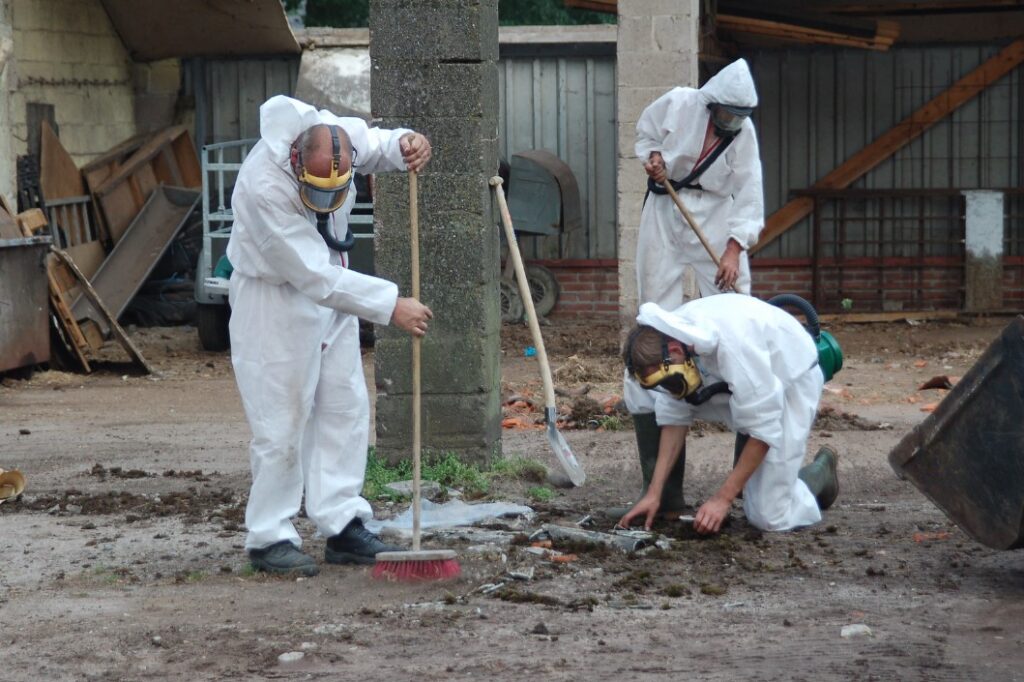Since its ban in 1994, the Netherlands has set the benchmark in Europe for a low occupational exposure limit (OEL) for asbestos, a known carcinogen. How did unions, employers and national authorities together achieve this drastic reduction, and is it working in practice?
by Pien Heuts, journalist
Since its ban in 1994, the Netherlands has set the benchmark in Europe for a low occupational exposure limit (OEL) for asbestos, a known carcinogen. In 2017, the country reduced the OEL even further to 2,000 fibres per cubic metre. Compared to the current European standard of 100,000 fibres per cubic metre, and even to the European Commission’s latest proposal to lower the limit to 10,000, the Netherlands stands out. How did unions, employers and national authorities together achieve this drastic reduction, and is it working in practice?
Wim van Veelen, policy adviser at the Netherlands Trade Union Confederation (FNV), has no trouble explaining why the Netherlands has the lowest OEL value in Europe when it comes to occupational exposure to asbestos fibres. “Along with the UK, we are sitting on the largest asbestos mountain in Europe,” he explains. “More than 800 people still die each year from mesothelioma as a consequence of exposure to asbestos. Before asbestos was banned in 1994, we used it absolutely everywhere. Not only was it nice and cheap, but it was also durable as an insulating and fire-resistant material. It went into roofs, doors, stairs, walls, ceilings, installations, brake linings and in shipping too. What wasn’t it used in? And because we know that asbestos is one of the most dangerous killers in the workplace, we’ve done everything we can to drastically reduce the number of fibres that workers may be exposed to and still work as safely as possible. In any case, the Netherlands is generally strict when it comes to exposure to carcinogenic substances in the workplace.”
After a ban on the use and marketing of asbestos came into force in the Netherlands in 1994, a limit of 10,000 fibres per cubic metre (fibres/m³) was included in the Dutch Working Conditions Decree. This decree contains rules that all employers and employees must obey in order to counter occupational risks and to create a working environment that is as safe and healthy as possible. Even with its national OEL of 10,000 fibres/m³, the Netherlands was the frontrunner in Europe. Most countries just adhered to the (ten-fold higher) European standard of 100,000 fibres/m³, and still do.
Wrangling over the exposure limit
Every four years, the Health Council of the Netherlands, an independent scientific council that advises the country’s lawmakers, considers which hazardous substances need to be examined more closely and whether the existing OELs are still sufficiently protective from the point of view of exposure and the health impact. In 2010, the spotlight was again placed on asbestos. The council found that the health risks of asbestos were far more serious than expected, making the limit of 10,000 fibres/m³ no longer adequate. As a result, the Health Council recommended that the threshold be lowered from 10,000 fibres/m³ to 2,000 fibres/m³ for chrysotile asbestos and to 420 fibres/m³ for amphibole asbestos[1].
“Along with the UK, we are sitting on the largest asbestos mountain in Europe.”
However, lowering the level of exposure on paper does not automatically create safer working conditions or reduce risks. The exposure reduction needs to be achievable at the workplace and the OEL needs to be technically measurable. Jody Schinkel, business development manager at the TNO, the Netherlands Organisation for Applied Scientific Research, knows all about this. He is responsible for the asbestos dossier at the TNO. When asked by the Ministry of Social Affairs and Employment to investigate whether the proposed lower thresholds could be achieved, the TNO assessed eight hundred personal exposure measurements collected from asbestos remediation companies. “We investigated the levels of exposure during the removal of asbestos. We looked at what safety measures and personal respiratory protective equipment could be used and whether the OELs were measurable. During the study, we explored whether the recommended threshold was achievable for both types of fibre: chrysotile (2,000) and amphibole (420). We found that this was the case for the first type. With the amphiboles, however, it was technically impossible to reduce the fibre concentration in the air to 420 fibres/m³ using existing methods. What’s more, such a low concentration is barely measurable with the available analysis techniques.”
The results of the TNO investigation were discussed by employers and employees on the Committee for Occupational Exposure Limits for Substances in the Workplace, which was set up by the Social and Economic Council of the Netherlands, an important advisory council for the country’s lawmakers. In 2014, social partners agreed on the OEL reduction at 2,000 fibres/m³ for chrysotile asbestos but the employers’ and workers’ representatives could not agree on the limit for amphibole asbestos, so it remained at 10,000 fibres for a few more years, against the FNV’s wishes.
Three years later, employers and employees finally agreed on the reduction of the OEL for amphibole asbestos and a favourable recommendation was then presented to the minister and set down in law. “We did wrangle a bit about the introduction of the lower limit,” says Wim van Veelen, who has represented the FNV, the largest trade union in the Netherlands, on that committee for many years. “Employers complained bitterly, of course, that they might have to close down or move to another country. And we, as employees, stressed the importance of a safe and healthy workplace. After all, we’re talking about this most carcinogenic substance that has taken the lives of far too many workers. Employers are well aware of this in the Netherlands, but certainly don’t always behave accordingly.”
The residual risk of an exposed worker developing asbestos-related cancer is ten times lower with an OEL of 1,000 fibres/m³ than with an OEL of 10,000 fibres/m³.
In 2017, a legal value of 2,000 fibres/m³ was thus introduced for all types of asbestos. It was considered that at this level of exposure, the residual risk of developing mesothelioma or lung cancer in exposed workers was sufficiently low and acceptable.
European standard
The national OELs for asbestos vary from one country to another in Europe. Many countries apply the European standard of 100,000 fibres/m³, which the European Commission wants to lower to 10,000, matching that in countries such as France and Germany. The European trade unions are targeting 1,000 fibres/m³. The residual risk of an exposed worker developing asbestos-related cancer is ten times lower with an OEL of 1,000 fibres/m³ than with an OEL of 10,000 fibres/m³.
One of the TNO’s conclusions is that a harmonised European approach would contribute to a level playing field. Uniform methods for measuring and analysing would be part of this. Schinkel, who emphasises that the TNO’s input is purely scientific and has nothing to do with policy or health advice, says: “It would be good if everyone in Europe could adopt the same approach to measuring and counting fibres. Right now, different countries apply various methods that produce a range of results. Asbestos removal should be carried out in the same safe manner everywhere, under the same conditions. With 2,000 fibres/m³, the Netherlands has taken a positive step, and one that is achievable in practice.”
“It really is crazy for Europe not to follow the example of a country where, thanks to the most advanced techniques, low exposure to a really dangerous substance is the norm. This is in the health interests of workers. The lower the exposure limit throughout Europe, the safer the workplace,” says the FNV’s Van Veelen, angry because the current differentiation across the continent flies in the face of the fact that the risks of exposure to asbestos are the same in every country. “Should a Bulgarian or Romanian employee run a greater risk than a Dutch one? Isn’t Europe supposed to ensure that every worker can expect the same protection?”
“The Member States in Europe cannot be allowed to use different measurement methods and counting rules.”
Van Veelen feels that the European discussion is not being conducted honestly because the difference in measurement methods is being exploited. “Other countries measure different, thinner types of fibre, so the results are different. On this basis, the European Commission is claiming that the proposed standard of 10,000 fibres/m³ is a bit like the 2,000 in the Netherlands. This is not a fair comparison. The Member States in Europe cannot be allowed to use different measurement methods and counting rules. We need a precise determination of exactly what to measure and what equipment to use for this. That is fundamental. If the Netherlands can get rid of such a large mountain of asbestos with a stricter standard, then surely other countries can too. We have a good approach to this. Employers and employees are in agreement on this exposure limit. That’s why we are investing in protecting workers during the necessary asbestos remediation projects.”
Tough on enforcement
If you lower the limit values, you do so in the hope that the exposure will be reduced for employees, says Jody Schinkel from the TNO. “But then employers still have to comply with the new measures in order to meet that standard, and this needs to be monitored. Responsibility lies with employers and employees. It is very much about being aware of the danger. Simply enforcing the rules is not enough.” Wim van Veelen from the FNV describes the world of asbestos removers in the Netherlands in the past as a murky one with a lot of cowboys. According to him, the strict rules on removal have ensured that more remediation firms now toe the line more, and this means that employees are better protected during their work.
Companies that remove asbestos have to be certified, and certification bodies pay a visit several times a year to check whether they are meeting the requirements. What’s more, the Netherlands Labour Authority, part of the Ministry of Social Affairs and Employment, supervises compliance with the Dutch Working Conditions Act. Inspectors who suspect that asbestos is not being removed properly engage an inspector who specialises in asbestos. In addition, around a hundred supervisors from Environmental Agencies (a collaboration between provinces and municipalities) supervise asbestos remediation projects in terms of the risks to the public and the environment. “This extensive supervision by Environmental Agencies and certification bodies means that the checks are intensive. We complement each other well,” says Louise Hontelez, asbestos programme manager at the Netherlands Labour Authority. Roughly a third of the asbestos remediation companies checked are found to be non-compliant. But the penalties are severe and range from imposing fines to shutting down operations or ordering business closures.
This paper was first published in HesaMag #27.
[1] Chrysotile asbestos (curled fibres) is less potent for the induction of mesothelioma than the amphibole forms of asbestos (straight, needle-like fibres).
Cover photo: Three men removing asbestos on a farm, by Albert Ter Harmsel via Flickr (CC-BY-2.0 DEED) https://creativecommons.org/licenses/by/2.0/



